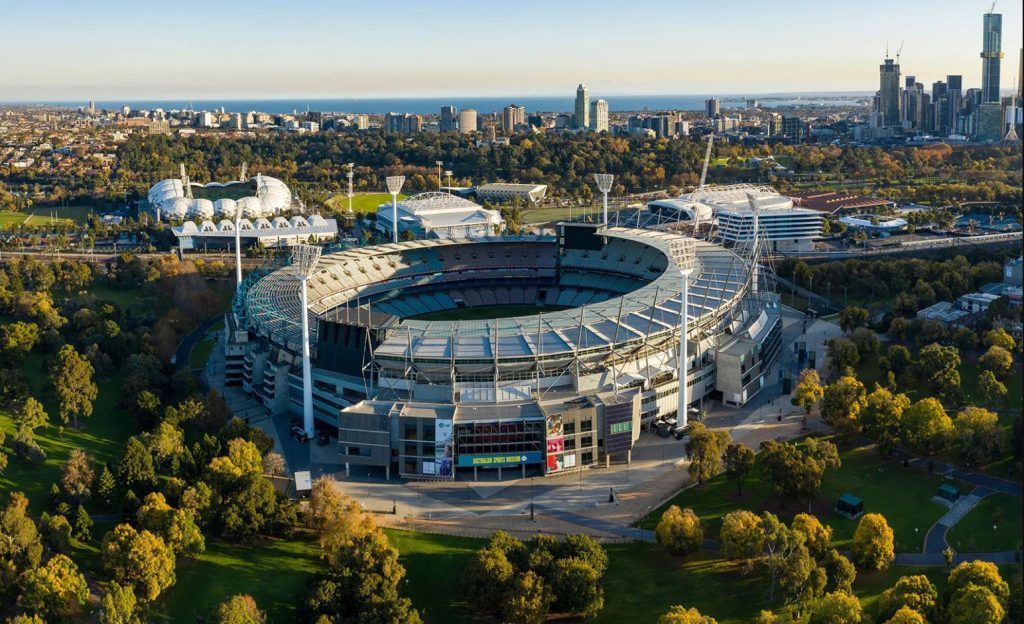Australia is known for its rich cricketing heritage, and its stadiums reflect the grandeur and enthusiasm for the sport. The size of cricket grounds varies significantly, impacting the style of play, boundary hitting, and even pitch conditions. Boundary length, the distance from the pitch’s center to the perimeter rope, is a crucial factor that influences gameplay dynamics. Larger boundaries often favor bowlers and fielders, while smaller ones encourage aggressive batting.
Table of Contents
This article delves into some of the biggest cricket grounds in Australia, ranked by their boundary lengths, providing insights into their dimensions and unique characteristics.
Understanding Boundary Length in Cricket Grounds
The boundary length is measured from the center of the pitch (the middle of the wicket) to the edge of the playing field (boundary rope). Cricket laws require that boundaries must be a minimum of 59.43 meters (65 yards) from the center of the pitch, but there’s no official maximum limit.
Larger grounds with longer boundaries make it harder to score sixes and fours, influencing team tactics and player performances. Grounds with big boundaries often see more running between wickets and fewer high-scoring matches.
Top Australian Cricket Grounds by Boundary Length
| Ground Name | Location | Average Boundary Length (meters) | Maximum Boundary Length (meters) | Capacity |
|---|---|---|---|---|
| Melbourne Cricket Ground (MCG) | Melbourne, VIC | 75 – 83 | 85 | 100,024 |
| Adelaide Oval | Adelaide, SA | 70 – 75 | 80 | 53,500 |
| Sydney Cricket Ground (SCG) | Sydney, NSW | 65 – 75 | 78 | 48,000 |
| The Gabba | Brisbane, QLD | 68 – 72 | 74 | 42,000 |
| Bellerive Oval | Hobart, TAS | 65 – 70 | 72 | 20,000 |
| Perth Stadium (Optus) | Perth, WA | 70 – 80 | 82 | 60,000 |
| Manuka Oval | Canberra, ACT | 65 – 70 | 73 | 15,000 |
1. Melbourne Cricket Ground (MCG)
The MCG is arguably Australia’s most famous and largest cricket ground. Its boundary length varies from approximately 75 meters on the shorter sides to up to 83 meters on the longer sides, with some measurements near 85 meters at the largest points.
- Boundary effect: The vast size allows for some of the longest sixes in cricket history.
- Playing style: Batsmen often have to work hard for runs, and bowlers benefit from the large field which aids field placements and catching opportunities.
- Seating capacity: Over 100,000, making it one of the largest stadiums globally.
2. Adelaide Oval
Renowned for its picturesque setting and historic pavilion, Adelaide Oval features boundary lengths averaging 70 to 75 meters, extending up to 80 meters at certain points.
- Boundary effect: Medium to large boundary size; balances batsmen and bowlers.
- Playing style: Encourages stroke play, especially along the shorter sides, but with enough space to reward timing and precision.
- Seating capacity: 53,500, with modern facilities after recent renovations.
3. Sydney Cricket Ground (SCG)
The SCG, with boundaries ranging between 65 and 75 meters, is slightly smaller than MCG and Adelaide but still considered a large ground.
- Boundary effect: Batsmen can often find gaps for fours, but the boundary size also favors spin and swing bowlers.
- Playing style: The SCG is known for spin-friendly pitches and tactical battles.
- Seating capacity: 48,000.
Comparison of Boundary Lengths and Their Impact
| Ground | Smallest Boundary (m) | Largest Boundary (m) | Notes on Impact |
|---|---|---|---|
| MCG | 75 | 85 | Favors bowlers; long sixes possible |
| Adelaide Oval | 70 | 80 | Balanced; supports stroke play |
| SCG | 65 | 78 | Slightly smaller; spin-friendly |
| The Gabba | 68 | 74 | Quicker pitches; medium boundaries |
| Perth Stadium | 70 | 82 | Fast bouncy pitches; long boundaries |
| Bellerive Oval | 65 | 72 | Smaller ground; aids aggressive batting |
| Manuka Oval | 65 | 73 | Smaller capacity; supports pace bowling |
Other Noteworthy Grounds
While the above are the major venues, several other Australian grounds also feature in domestic cricket, each with its unique size:
- WACA Ground (Perth): Known for its fast and bouncy pitches, the WACA’s boundaries vary between 65-75 meters.
- Blundstone Arena (Hobart): Known for tight boundaries on some sides, around 65-70 meters.
- Metricon Stadium (Gold Coast): Occasionally used for cricket, its boundaries are approximately 70 meters.
Why Boundary Length Matters
1. Tactical Considerations
Teams adjust strategies based on boundary size. On larger grounds, bowlers may employ tactics like more infielders to prevent quick singles, while batsmen focus on running between the wickets.
2. Player Selection
Batsmen known for timing and running may be favored on bigger grounds, while power hitters excel in smaller grounds with shorter boundaries.
3. Match Atmosphere
Australian cricket grounds boast a variety of sizes and boundary lengths, each contributing to the unique character of the venue and influencing gameplay. The Melbourne Cricket Ground remains the largest in terms of boundary length and seating capacity, challenging even the most powerful batsmen with its vast dimensions.
Understanding boundary length is essential for players, fans, and strategists alike, as it shapes the nature of cricket played across Australia — from the traditional battles at the SCG and Adelaide Oval to the fast-paced contests at Perth Stadium.
As cricket continues to evolve, boundary sizes remain a key part of the game’s tactical and entertainment elements in Australia.


